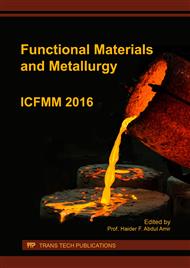p.103
p.108
p.115
p.120
p.125
p.131
p.137
p.142
p.148
Evaluation of Wear and Corrosion Resistances of Oxide Coatings Formed on Magnesium Alloys by Micro Arc Oxidation
Abstract:
In the present study, wear and corrosion resistances of magnesium alloys were analyzed after coated by micro arc oxidation (MAO) process for potential protection of gear component, which is the most wearing part of a conventional bicycle. Two of the most common magnesium alloys (AZ31 and AZ91) were used in the study and they were oxidized in three different electrolytes (aluminate-, silicate-and phosphate-based). Scanning electron microscopy (SEM) was utilized in order to analyze the coating morphology and wear tracks obtained during wear tests. Energy dispersive X-ray spectroscopy (EDS) analyses were implemented to determine the elemental composition of the coatings. Wear and corrosion tests were applied to compare the performances of the coatings. Experimental results showed that wear and corrosion resistances of the samples generally increased after coated by MAO process and the best protection against wear and corrosion related failures, was achieved by utilizing silicate-based electrolyte for MAO process of magnesium alloys under selected process parameters.
Info:
Periodical:
Pages:
125-130
Citation:
Online since:
September 2017
Authors:
Keywords:
Price:
Сopyright:
© 2017 Trans Tech Publications Ltd. All Rights Reserved
Share:
Citation:


